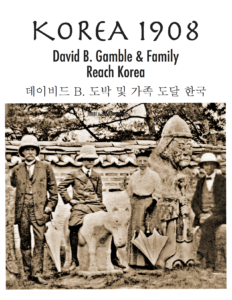Korea 1908
Sidney D. Gamble
& Brother Clarence Reach Korea
“My good friend, Miriam Reed, has just published a new book titled, Korea 1908: David B. Gamble Family Visit Korea. The book features period photos and journal entries never before available to the public. The Gamble family visited Korea in 1908 and witnessed the turmoil of a nation struggling to maintain its sovereignty and independence. They quickly realized that Korea will no longer exist as a nation, but merely as a resource for use by Japan.” – Wayne Kelly
AVAILABLE ON AMAZON
From the Schlesinger Library, Sarah Bradley Gamble Papers & Countway Medical Library, Clarence James Gamble Papers, Harvard University Archives
“Korea 1908”, with over ninety photographs and a transcript of the Clarence Journal, covers the almost three weeks that the Gambles spent in Korea in 1908. Immediately after their arrival in Busan, they took the train to Seoul, and Clarence takes note of the many soldiers on the train (as well as their heavy smoking) and the many troops lined up at each station. Clarence does not mention that the soldiers were Japanese soldiers. Yet they must have been. For by 1910, Korea was officially the protectorate of Japan and in 1908 firmly under Japanese military rule. Ito Hirobumi was the governing Japanese Resident General and attended the Decoration Day celebration on 30 May at the American Embassy, where David and Mary shook his hand. Clarence does not mention and was surely not aware that in downtown Seoul at this time were Japanese police, the notorious kenjie, comprising 2,369 Japanese and 4,065 Korean helpers and that in the countryside, Korea volunteers in the Righteous Army were waging guerrilla warfare against the occupying Japanese troops.
Clarence discusses the modernization of Seoul and Pyongyang. Streetcar and railroads were in regular use, and more were under construction. On Wednesday 10 June, Clarence and Sidney saw the partially built reservoir for the new water works of Pyongyang. All the Gambles attended the historic graduation of the first seven Western-trained Korean doctors under medical missionaries Dr. Oliver R, Avison and his assistant, Dr. Jesse Watson Hirst, and heard Ito Hirobumi speak at the graduation. The Gambles also saw the new Severance Hospital that had been built with Protestant missionary perseverance and American donations, including the substantial donation of Mr. Louis Severance of Standard Oil.
David and Mary Gamble were supporting medical and general education and the building of schools and colleges in Korea. Mary Gamble was early a feminist and a strong advocate of education for girls, and Clarence shared his mother’s feelings. He and Sidney took photographs of the classes at Mrs Miller’s Girls’ School, and all the Gambles attended graduation exercises. “It must have seemed very queer to the Coreans [sic],” wrote Clarence, “to see a girl get up in public and make a speech.” He then remarked that the men had always thought the women “were next to idiots and now they were to see that they were far from it.”
It was not until the Gambles were preparing to leave Korea that they encountered the harshness of the Japanese occupation and were made to question the treaty arranged by President Theodore Roosevelt that ended the Russo-Japanese War in 1904. The treaty brought Roosevelt the Nobel Peace Prize in 1906 and over fifty years of Japanese rule to Korea.


